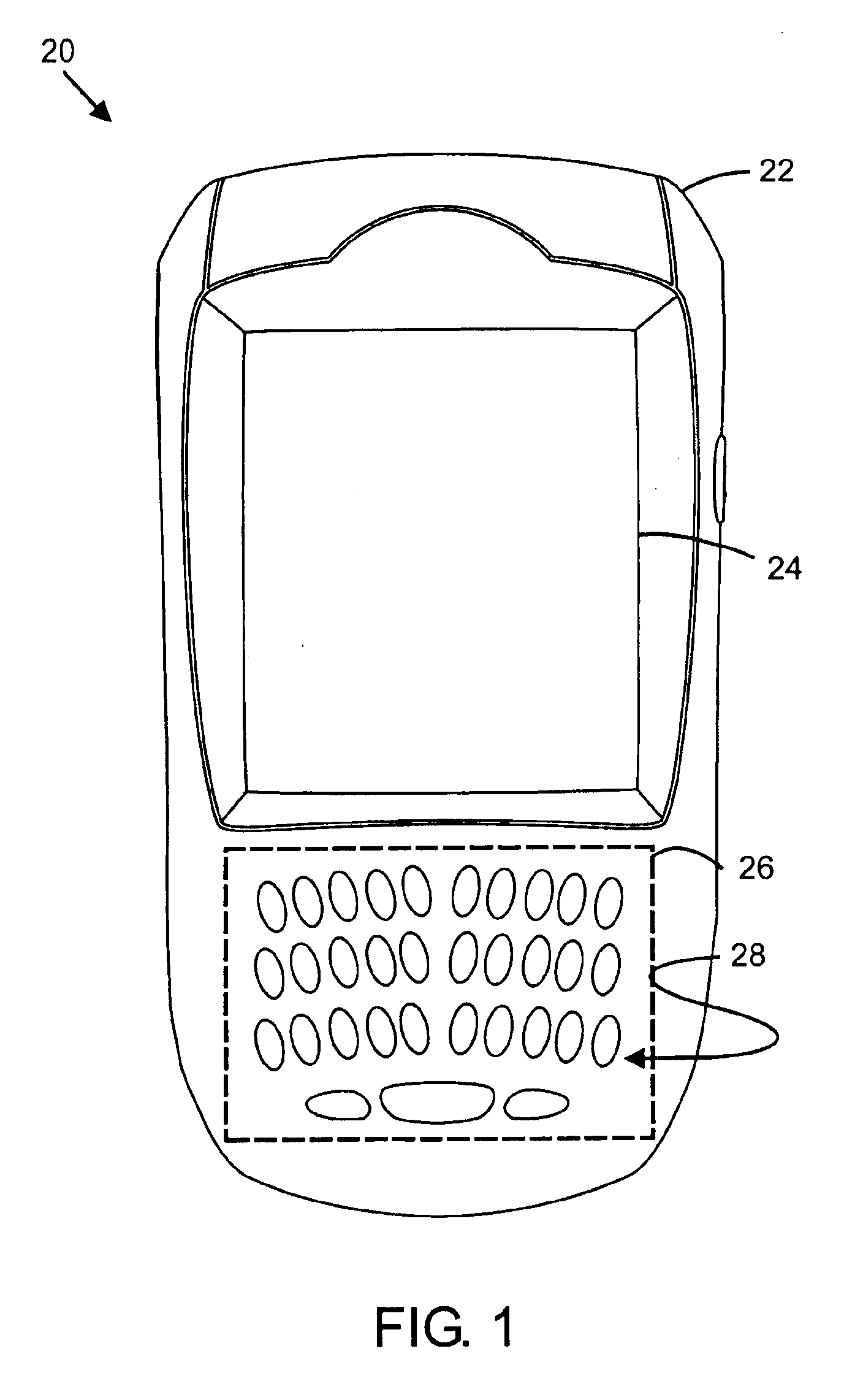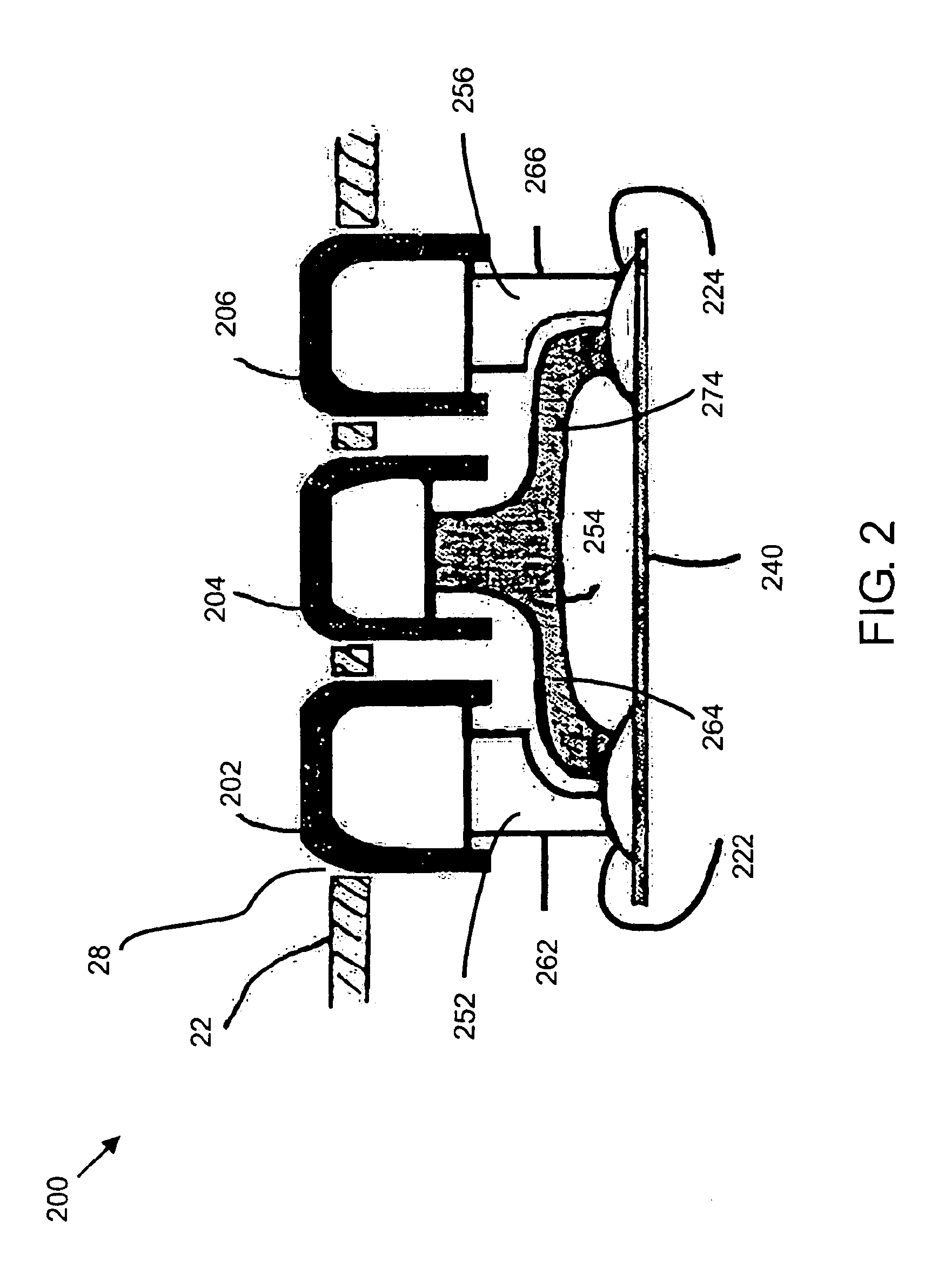Keyboard assembly for a mobile device
a mobile device and keyboard technology, applied in the field of keyboards and keypads, can solve the problems of limited pcb space and large number of individual keys, and achieve the effect of increasing the number of individual keys and increasing the spa
- Summary
- Abstract
- Description
- Claims
- Application Information
AI Technical Summary
Benefits of technology
Problems solved by technology
Method used
Image
Examples
first embodiment
[0027]FIG. 2 illustrates a side view of a keyboard assembly 200 according to the present invention. The term keyboard assembly is used herein to describe the collection of physical components that together allow a device to accept user inputs via a plurality of keys. These physical components can include, but are not limited to: keys, actuators, dome switches, and a printed circuit board.
[0028]Keys 202, 204 and 206 preferably protrude through openings 28 in the device housing 22. Although only three keys are shown in FIG. 2 for simplicity of illustration and explanation, it will be apparent to one skilled in the art that a keyboard can include many more such keys. Each key actuates an input or function when a user depresses the key, thereby depressing at least one dome switch 222, 224, each of which is disposed on a printed circuit board (PCB) 240. Conventionally, each key is associated with an individual dome switch. According to the present invention, each key is associated with o...
second embodiment
[0035]FIG. 3 illustrates a side view of a keyboard assembly 300 according to the present invention. The embodiment in FIG. 3 is similar to that illustrated in FIG. 2 in the layout of keys 302, 304, 306 and of dome switches 322 and 324 on PCB 340. The embodiment in FIG. 3 provides for a different design of an actuator used in conjunction with an end key, i.e. a key that is at an end of a row of keys. Actuators 352 and 356 in FIG. 3, in addition to having arms 362 and 366 for actuating the dome switches 322 and 324, respectively, also have arms 372 and 376. Each of the arms 372 and 376 does not engage a dome switch, but maintains the balance of the key when it is depressed. Any of the actuators 352, 354 and 356 can alternatively comprise one or more additional arms for actuating further dome switches on adjacent horizontal or vertical rows. Any of these actuators can further alternatively comprise one or more additional arms that does not engage a dome switch, but maintains the balanc...
third embodiment
[0036]FIG. 4 illustrates a top view of a keyboard assembly 400 according to the present invention with different layers shown in dashed lines. In this embodiment, keys are laid out in rows and dome switches are laid out in rows between the rows of keys such that the dome switches are positioned between two adjacent keys in a row. A dome switch is then preferably associated with four diagonally adjacent keys. Although a PCB is not illustrated in FIG. 4, it is to be understood that the keyboard arrangement 400 includes a PCB on which the dome switches are disposed. Although actuators and dome switches are both illustrated in dashed lines, it is to be understood that these two sets of elements are themselves on different layers, each different from the key layer. Three different types of key and actuator arrangements will now be described in relation to the embodiment illustrated in FIG. 4.
[0037]A key 402 in a top right corner of the keyboard assembly 400 is arranged so as to actuate o...
PUM
 Login to View More
Login to View More Abstract
Description
Claims
Application Information
 Login to View More
Login to View More - R&D
- Intellectual Property
- Life Sciences
- Materials
- Tech Scout
- Unparalleled Data Quality
- Higher Quality Content
- 60% Fewer Hallucinations
Browse by: Latest US Patents, China's latest patents, Technical Efficacy Thesaurus, Application Domain, Technology Topic, Popular Technical Reports.
© 2025 PatSnap. All rights reserved.Legal|Privacy policy|Modern Slavery Act Transparency Statement|Sitemap|About US| Contact US: help@patsnap.com



